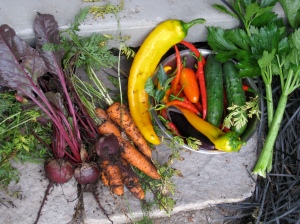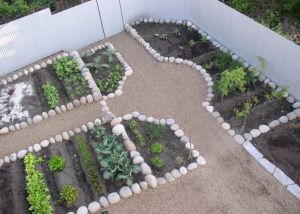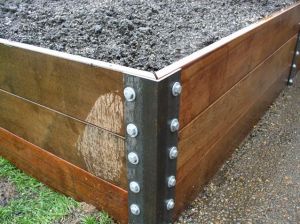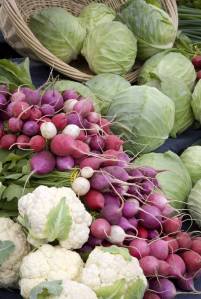
At first glance, the geometric structure required by the way most of us garden (rows of vegetables in rectangular or rectangular-ish raised beds, surrounded by straight paths) may seem limited, but a little thought and creativity offers a range of solutions and feelings from formal and sculptural to whimsical. We consider the necessary rectangular forms and pathways a jumping off point for design, rather than a limitation. Once we've got the basic form in mind, we consider materials for borders or retaining. Stone, metal, and wood all present a variety options for finishing the structure of a garden.

In our garden, the best space for the veggie garden was in a lower, sunny corner of our property. The straight lines of the paths and circular "roundabout" continue the overall design of the ornamental garden, and the pea gravel paths and surrounding corrugated, galvanized fence emphasize an overall continuity of materials. Rather than continuing to use the rough, straight edged basalt that forms the borders, walls and stairs of our ornamental garden, however, we bordered our raised beds in large, round river rock. The river rock softens the lines of the veggie garden, and playfully frames the herbs, strawberries and other low plants that spill over the borders. The aesthetic center of our veggie garden is the Vietnamese urn water feature at the intersection of our main paths. The urn is visible from the upper garden and punctuates the long axis of our narrow space. The circular space around the urn cuts into the straight lines of our raised beds, at once playing off of and playing with the surrounding, mostly rectangular, geometry.
Our space reflects our desires and priorities (cohesiveness of design and maximizing usable space, among others). The veggie gardens we have created for clients vary with their goals. One client was a busy mother with a strong design sense. She wanted to involve her young boys in growing some food, but she was more interested in having a "sculptural" garden that was easy for her and the boys to work than in maximizing planting space that she would not have time to maintain. We built three long, narrow, rectangular raised beds from dry stack basalt. Their unusual forms look great even in winter, and grow gorgeous peppers and other heat-loving crops in the summer.


Another client wanted a simple, contemporary box for their veggies. The catch was their request for a portable design they could take with them if they moved. We bolted ipe (a sustainably forested tropical hardwood) to rusting metal corners, which extended below the wood and doubled as stakes to hold the box in place.
There are so many more ideas and materials to try, and we love the challenges and rewards in designing vegetable gardens. Just the ideas for retaining (vertical flagstone, rusting metal, how about a mini-gabion wall?) seem endless. Each space and lifestyle offers challenges and inspiration for design well outside the ubiquitous cedar box.
iA Little Help
We love growing food. Our veggie garden and orchard take a third or so of our usable garden space, and we dream of having more space to grow all of the things that we can't cram into our little property (brussels sprouts! pumpkins!). That said, our expertise is in landscape design and construction, not in producing food, and what success we have in growing fruits and vegetables is due in large part to research and strategic questioning of farmers and home gardeners many times more experienced and knowledgeable than we are. Below are a few of our favorite resources. We'd love to hear about yours!

- The Lane County Farmer's Market and other local farmer's markets - Local farmers know what, when, where and how to plant, cultivate and harvest, and most of them are generous with advice. Two of our favorite farmers at the market are Grateful Harvest and Ruby and Amber's (they cultivate by horse power!). The market is also the place to buy starts in the spring - try Ruby and Amber's tomato starts next year....
- Growing Vegetables West of the Cascades by Steve Salomon - Everything from planting calendars to best varieties for our area.... This is the Willamette Valley veggie geek's best friend. It has awfully high expectations for those of us on smaller lots, and we would quibble with a few particulars, but our copy is dirt smudged and dog-eared for a reason.
- Territorial Seed Company - Seeds and starts grown in Oregon, with many organic options available. One of our greatest early season joys is the March delivery of the year's seeds.
- The Oregon State Extension service - lots of information on fruits, vegetables, pests, and regional differences. We just found this cool pdf with information and planting calendars for different regions of the state.
- Robin Bachtler Cushman's photographs are terrific inspiration. She chronicles our local farms and vegetable gardens. If you happen to be on the LCC campus before September 21, her work is part of a show, "Markets," at the David Joyce Gallery.
These are just a handful of the terrific local and regional resources, including many exceptional home gardeners who are happy to share their experience and advice with the rest of us.
Thanks for keeping up with us! Fall is a wonderful time to be outside, and we hope the next month brings plenty of beautiful weather for gardening and other adventures.
Best,
Rebecca & Buell